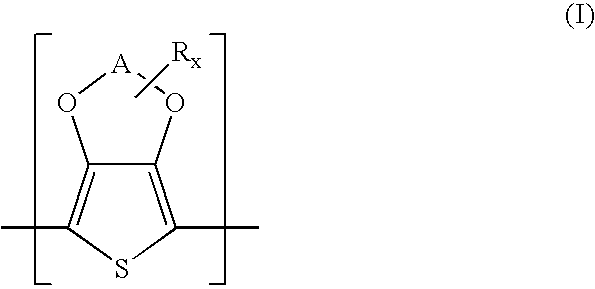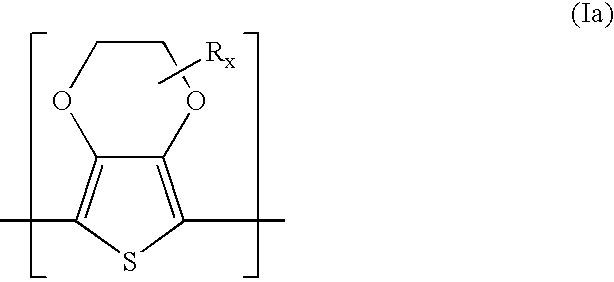Transparent polymeric electrodes for electro-optical structures, processes for producing the same, and dispersions used in such processes
a technology of transparent polymeric electrodes and electrooptical structures, which is applied in the direction of discharge tube/lamp details, final product manufacturing, synthetic resin layered products, etc., can solve the problems of not being able to build very thin lighting elements, and not being able to achieve the same
- Summary
- Abstract
- Description
- Claims
- Application Information
AI Technical Summary
Benefits of technology
Problems solved by technology
Method used
Image
Examples
example 1
Production of a PEDT:PSA Dispersion for Producing the First Electrode Layer:
[0123] a) (According to the invention) In a commercially obtainable aqueous polyethylenedioxythiophene / polystyrene sulfonic acid dispersion (PEDT:PSA dispersion) with a polyethylenedioxythiophene / polystyrene acid weight ratio of 1:2.5, a solids content of approx. 1 wt. % and a viscosity of approx. 300 mPas at a shear rate of 100 s−1 and at 20° C. (Baytron® PHC V4 from H.C. Starck GmbH), a particle size distribution with a d50 value of 25 nm, i.e. 50 wt. % of the particles smaller than 25 nm, was established by homogenisation. The dispersion was then concentrated from approx. 1 wt. % to a solids content of 1.7 wt. %, filtered (Pall, pore size: 0.2 μm) and then mixed with 5 wt. % dimethyl sulfoxide (DMSO). The viscosity of this solution was approx. 45 mPas at a shear rate of 100 s−1 and at 20° C.
[0124] b) (Comparative example) A commercially obtainable aqueous PEDT:PSA dispersion with a polyethylenedioxythi...
example 2
Production and Characterisation of a First Electrode Layer:
[0126] a) (According to the invention) Glass substrates were cut to a size of 50×50 mm2, cleaned and activated for 15 minutes with UV / ozone. The dispersion from example 1a) was then distributed over the glass substrate by means of a spin coater at the specified spin speed and an acceleration of 500 rpm / sec for 30 seconds. Parallel silver contacts were vapour deposited using a shadow mask and the surface resistance was determined. The film thickness was determined with a stylus profilometer (Tencor 500), the surface roughness with a scanning force microscope (Digital Instruments).
[0127] b) (Comparative example) Glass substrates were prepared as described in 2a), coated with a dispersion from example 1b) and their standard colour value, surface resistance, film thickness and surface roughness were determined.
[0128] c) (Comparative example) Glass substrates were prepared as described in 2a), coated with a dispersion from ex...
example 3
Production of an OLED without a Second Electrode Layer
[0130] 1. Substrates with Metallic Fingers:
[0131] Glass substrates were cut to a size of 50×50 mm2 and cleaned. Then metal fingers in silver were vapour deposited onto the substrate using a shadow mask. The parallel metal lines with a width of 1 mm and a distance of 5 mm apart were connected by means of a central bar running perpendicular to them and had a height of 170 nm. Immediately before coating, the substrate surfaces were cleaned and activated with UV / ozone (UVP Inc., PR-100) for 15 minutes.
[0132] 2. Application of a First Electrode Layer Using a PEDT:PSA Dispersion According to the Invention:
[0133] Approx. 2 ml of the dispersion from example 1a) were poured onto the substrate and then distributed on the glass substrate with the metal fingers using a spin coater at 1000 rpm and an acceleration of 500 rpm / sec for 30 seconds. The substrate with the still wet electrode layer was then placed on a hot plate, covered with a...
PUM
| Property | Measurement | Unit |
|---|---|---|
| surface roughness Ra | aaaaa | aaaaa |
| thickness | aaaaa | aaaaa |
| temperature | aaaaa | aaaaa |
Abstract
Description
Claims
Application Information
 Login to View More
Login to View More - R&D
- Intellectual Property
- Life Sciences
- Materials
- Tech Scout
- Unparalleled Data Quality
- Higher Quality Content
- 60% Fewer Hallucinations
Browse by: Latest US Patents, China's latest patents, Technical Efficacy Thesaurus, Application Domain, Technology Topic, Popular Technical Reports.
© 2025 PatSnap. All rights reserved.Legal|Privacy policy|Modern Slavery Act Transparency Statement|Sitemap|About US| Contact US: help@patsnap.com



